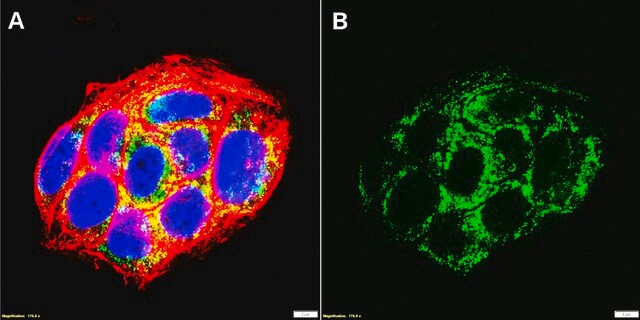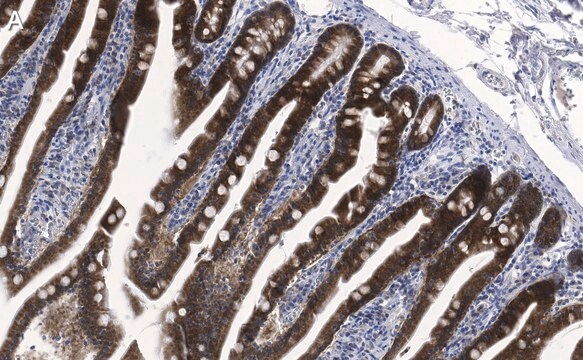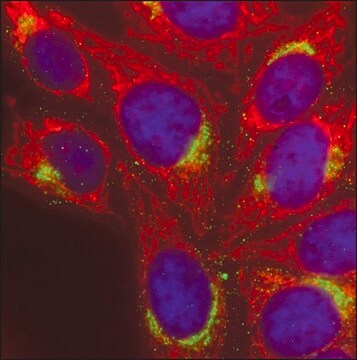詳細
We are committed to bringing you greener alternative products, which adhere to one or more of The 12 Principles of Green Chemistry.This antibody is Preservative-free, produced without the harm or sacrifice of animals and exceptionally stable to allow for ambient shipping and storage if needed and thus aligns with "Waste Prevention", "Designing Safer Chemicals" and "Design for Energy Efficiency".
Click here for more information.
ZooMAb® antibodies represent an entirely new generation of recombinant monoclonal antibodies.Each ZooMAb® antibody is manufactured using our proprietary recombinant expression system, purified to homogeneity, and precisely dispensed to produce robust and highly reproducible lot-to-lot consistency. Only top-performing clones are released for use by researchers. Each antibody is validated for high specificity and affinity across multiple applications, including its most commonly used application. ZooMAb® antibodies are reliably available and ready to ship when you need them.
特異性
Clone 1N11 is a ZooMAb® rabbit recombinant monoclonal antibody that specifically detects TGF-β receptor 2. It targets an epitope within 22 amino acids from cytoplasmic domain in the N-terminal half.
免疫原
KLH-conjugated linear peptide corresponding to 22 amino acids from the cytoplasmic domain in the N-terminal half of human TGF-β receptor 2 (TGFBR2).
アプリケーション
Quality Control Testing
Evaluated by Western Blotting in HeLa cell lysate.
Western Blotting Analysis: A 1:1,000 dilution of this antibody detected TGFBR2 in HeLa cell lysate.
Tested applications
Western Blotting Analysis: A 1:1,000 dilution from a representative lot detected TGFBR2 in A549 cell lysate.
Affinity Binding Assay: A representative lot of this antibody bound TGFBR2 peptide with a KD of 2.3 x 10-6 in an affinity binding assay.
Immunocytochemistry Analysis: A 1:100 dilution from a representative lot detected TGFBR2 in HepG2 and NIH3T3 cells.
Immunohistochemistry (Paraffin) Analysis: A 1:1,000 dilution from a representative lot detected TGFBR2 in human tonsil tissue sections.
Note: Actual optimal working dilutions must be determined by end user as specimens, and experimental conditions may vary with the end user
Evaluated by Western Blotting in HeLa cell lysate.
Western Blotting Analysis: A 1:1,000 dilution of this antibody detected TGFBR2 in HeLa cell lysate.
ターゲットの説明
TGF-beta receptor type-2 (UniProt: P37173; also known as EC:2.7.11.30, TGFR-2, TGF-beta type II receptor, Transforming growth factor-beta receptor type II, TGF-beta receptor type II, TbetaR-II) is encoded by the TGFBR2 gene (Gene ID: 7048) in human. TGF-β receptor II is a single-pass type I membrane protein that is synthesized with a signal peptide (aa 1-22), which is subsequently cleaved off to generate the mature active protein that contains an extracellular domain (aa 23-166), a transmembrane domain (aa 167-187), and a cytoplasmic domain (aa 188-567). Its protein kinase domain resides in amino acids 244-544 in the cytoplasmic domain. TGF- β1, 2, and 3 homodimeric ligands assemble a functional receptor that is composed of two TGF-β receptor I and TGF-β receptor II receptor II to form a ligand-receptor heterohexamer. TGF-β receptor II transduces the TGF- β1, 2, and 3 signal from the cell surface to the cytoplasm and regulates abundant physiological and pathological processes including cell cycle arrest in epithelial and hematopoietic cells, control of mesenchymal cell proliferation and differentiation, wound healing, extracellular matrix production, immunosuppression, and carcinogenesis. The formation of the receptor complex that is composed of two TGF-β receptor I and two TGF-β receptor II molecules symmetrically bound to the cytokine dimer results in the phosphorylation and the activation of TGF-β receptor I by the constitutively active TGF-β receptor II. Activated TGF-β receptor I then phosphorylate SMAD2, which dissociates from the receptor and interacts with SMAD4. The SMAD2-SMAD4 complex is subsequently translocated to the nucleus where it modulates the transcription of the TGF-β regulated genes. Two isoforms of TGF-β receptor II have been described that are produced by alternative splicing. This ZooMAbZooMAb® recombinant monoclonal antibody, generated by our propriety technology, offers significantly enhanced specificity, affinity, reproducibility, and stability over conventional monoclonals. (Ref.: Vander Ark, A., et al. (2018). Cell Signal. 52; 112-120; Huang, F., and Chen, Y-G. (2012). Cell Biosci. 2; Article 9).
物理的形状
Purified recombinant rabbit monoclonal antibody IgG, lyophilized in PBS, 5% Trehalose, normal appearance a coarse or translucent resin. The PBS/trehalose components in the ZooMAb formulation can have the appearance of a semi-solid (bead like gel) after lyophilization. This is a normal phenomenon. Please follow the recommended reconstitution procedure in the data sheet to dissolve the semi-solid, bead-like, gel-appearing material. The resulting antibody solution is completely stable and functional as proven by full functional testing. Contains no biocide or preservatives, such as azide, or any animal by-products. Larger pack sizes provided as multiples of 25 μL.
再構成
300 μg/mL after reconstitution at 25 μL per vial. Please refer to guidance on suggested starting dilutions and/or titers per application and sample type.
保管および安定性
Recommend storage of lyophilized product at 2-8°C; Before reconstitution, micro-centrifuge vials briefly to spin down material to bottom of the vial; Reconstitute each vial by adding 25 μL of filtered lab grade water or PBS; Reconstituted antibodies can be stored at 2-8°C, or -20°C for long term storage. Avoid repeated freeze-thaws.
法的情報
ZooMAb is a registered trademark of Merck KGaA, Darmstadt, Germany
免責事項
Unless otherwise stated in our catalog or other company documentation accompanying the product(s), our products are intended for research use only and are not to be used for any other purpose, which includes but is not limited to, unauthorized commercial uses, in vitro diagnostic uses, ex vivo or in vivo therapeutic uses or any type of consumption or application to humans or animals.








